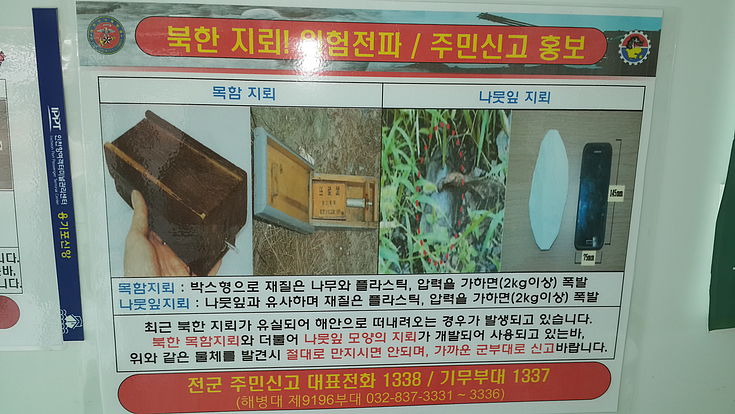Environmental Conservation and transboundary Cooperation in the Yellow Sea – The Importance of Baegnyeong-do
The military situation is tense – here a warning of North Korean mines.
In the Armistice Agreement of 1953, Baegnyeong-do was assigned to South Korea and belongs to the urban area of Incheon as a part of the Ongjin district since. The Northern Limit Line, the maritime demarcation line between North and South Korea, is situated only 7km North of it. The island has a population of 4500, however three times as many soldiers, because of the exposed position of the island and the high tensions in the Yellow Sea. No government of South Korea has so far been able to overcome those tensions.
Baegnyeong-do, with its geographically exposed, yet from South Korea with is tremendous economic development isolated location, has an important ecological function. On the one hand, it is the breeding area of many rare bird species like the Chinese egret, the Black-faced Spoonbill that is only home to China and South Korea, and other species. In the past, the island was also home to the oriental stork, which now only appears as a winter bird with a decreasing tendency there as well. Baegnyeongdo is also especially important, because it is an absolute bottleneck on the Asian-Pacific Flyway, through which hundreds of thousand migratory birds rest on the way to the North.
The island is also important for mammals such as the highly endangered spotted seal (phoca largha) in the Yellow Sea that only can be found in China and Korea, as well as finless porpoises and common mink wales.
The massive expansion of the military, but even more of civil, regional political expansion measures of the infrastructure, which are often completely over dimensioned and little purposive, have – just like in other Korean regions – led to a massive shrinking in habitats for migratory birds in the last couple of years. This especially applies to the last existing swamp in which the Black-faced Spoonbill in summer and oriental stork in winter showed a certain attraction for tourists. But the recent construction of a road, which shortens the way around the area by only two to three minutes, has led to strong disturbances now.
For five years, Birds Korea, our partner in the nature conservation projects in the inner-Korean border area as well as North Korea, has done ongoing research on the ecological changes on the island, which is significant for North Korea. The area lies directly on the passage on which Oncheon (Hwanghae-namdo) and Mundok (Pyongan-bukdo) are also situated, in which we conducted several consultation visits. Through this research, the importance of Baegnyeong-do in the Asian-Pacific Flyway became apparent, but also the high threat to this function through misdirected development on the other hand.
In cooperation with the citizens if Baegnyeong-do, Birds Korea and the Hanns Seidel Foundation in Koreaaim to deliberate on possibilities to improve the protection of remaining habitats on the island and also to sound out possibilities to create joint, trust-building measures in the border region with North Korea.
You can find more about the work of Birds Korea in Baegnyeong-do here.

